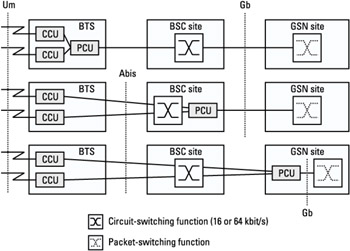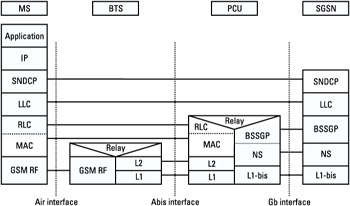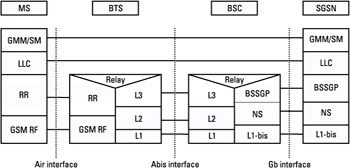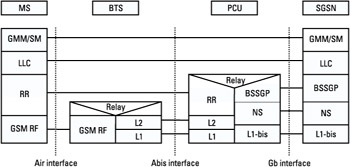BSS Architecture
3.4 BSS Architecture
3.4.1 PCU
In order to introduce GPRS within the BSS, the PCU concept has been defined. The PCU stands for a logical entity that manages packet toward the radio interface. The PCU communicates with the channel codec unit (CCU), positioned in the BTS.
The PCU is in charge of RLC/MAC functions such as segmentation and reassembly of LLC frames, transfer of RLC blocks in acknowledged or unacknowledged mode, radio resource assignment, and radio channel management. The CCU handles GSM layer 1 functions such as channel decoding, channel encoding, equalization, and radio channel measurements.
As shown in Figure 3.14, the PCU can be located either at the BTS site, the BSC site, or the SGSN site. When the PCU is located at the BSC or SGSN site, it is referred to as being a remote PCU.
 Figure 3.14: Remote PCU position. (From- [1].)
Figure 3.14: Remote PCU position. (From- [1].)
If the PCU is located at the BSC, it could be implemented as an adjunct unit to the BSC. When the PCU is located at the SGSN side, the BSC is transparent for frames transmitted between the PCU and the CCU. This PCU location implies the implementation of a signaling protocol between the BSC and the PCU (e.g., for time slot management, access on CCCH management). A protocol is also needed when the PCU is located at the BTS side.
In the case of remote PCU, GPRS traffic between the PCU and the CCU are transferred through the Abis interface. The Abis interface in GSM is based on TRAU frames carrying speech data and having a fixed length of 320 bits (every 20 ms). This corresponds to a throughput of 16 Kbps per Abis channel.
As the PCU is supporting functions such as RLC block handling (retransmission, segmentation, and so forth) and access control, it needs to know the GSM radio interface timing. This implies in the case of a remote PCU the design of a synchronous interface between the PCU and the CCU. The PCU must be able to determine in which radio frames is sent an RLC/ MAC block. In case of a PCU located at the BTS side, the PCU easily knows the radio interface time.
The remote PCU solution requires the sending of in-band information between the PCU and the CCU (for transmission power indication, channel coding indication, and synchronization between the CCU and the PCU).
The advantages and drawbacks of each solution are listed next.
PCU at the BTS Side
Advantages:
-
There is an internal interface between the PCU and the CCU.
-
There is a low round-trip delay (the round-trip delay is the time between the transmission of a block and the reception of the answer).
-
There is no waste of Abis bandwidth due to retransmission of RLC blocks.
Drawbacks:
-
There is a likely impact on the existing BTS hardware (when migrating from a circuit-switched network to a GPRS one). This is an important drawback considering the number of BTSs in the field.
PCU at the BSC Side
Advantages:
-
There is an internal interface between the PCU and the BSC.
Drawbacks:
-
There are likely hardware impacts on the current BSC (however, the number of BSCs is lower compared with the number of BTSs).
-
There is a greater round-trip delay.
-
A synchronous protocol is needed between the PCU and the CCU.
-
Abis bandwidth is wasted in case of RLC blocks retransmission.
PCU at the SGSN Side
Advantages:
-
There is no hardware impact on the current GSM network (BTS, BSC).
-
There is a smooth introduction of GPRS in the network.
Drawbacks:
-
There is a greater round-trip delay (longer TBF establishment).
-
A synchronous protocol is needed between the PCU and the CCU.
-
Abis bandwidth is wasted in case of RLC blocks retransmission.
-
A protocol is needed between the BSC and the PCU.
3.4.2 Transmission Plane
When the PCU function is not implemented in the BTS, a new protocol (L1/L2) between the PCU and the BTS is introduced. This protocol ensures transmission of RLC/MAC blocks from the PCU to the CCU, and allows in-band signaling for control of the CCU from the PCU and synchronization between both entities. Figure 3.15 shows the BSS transmission plane for a remote PCU.

Figure 3.15: BSS transmission plane for a remote PCU.
When the PCU is located in the BTS, a protocol (L1/L2/L3) is needed between the BSC and the BTS for the transmission of the LLC frames. The BSS transmission plane is shown in Figure 3.16.

Figure 3.16: BSS transmission plane when the PCU is in the BTS.
3.4.3 Signaling Plane
Depending on the PCU location, the signaling plane within the BSS will not be the same.
3.4.3.1 PCU in the BTS
The RR layer is at the BTS side. The (L1/L2/L3) protocol is used for the transmission of signaling between the BSC and the BTS. Figure 3.17 shows the signaling plane when the PCU is located in the BTS.

Figure 3.17: Signaling plane when PCU is in the BTS.
3.4.3.2 PCU at BSC or SGSN Side
The signaling plane implies the usage of the (L1/L2) protocol for RR signaling transmission. Figure 3.18 shows the signaling plane when the PCU is located at BSC side or SGSN side.

Figure 3.18: Signaling plane when PCU is at BSC or SGSN side.






